As I looked at some of my older editions of Forgotten Silver over Easter weekend, it dawned on me that I have not written an article specifically dedicated to a comic or series produced in British Columbia (BC) since May 2019, when I wrote about the “Great Lord Larry Mystery.” Since then, the closest I have come to writing a column focusing on comics from BC was my two-part series about environmental comics from the 1960s and 1970s. During that series of articles, I profiled Fraser Wilson’s Bill Northwood giveaway and also discussed several environmental underground comix from the province.
Some of the most significant comic output during the Canadian Silver Age happened in BC. Creators in the province were at the forefront of the underground movement (including notables such as Rand Holmes, Brent Boates, Bob Hunter and American expatriates George Metzger and Robert Inwood). This continued during the transition to alternative and mini-comics throughout the 1980s, with Colin Upton being one standout. The sheer breadth and continuity of comic creation in BC is something that only occurs elsewhere in Ontario and Quebec when considering the Canadian Silver Age geographically and over time.
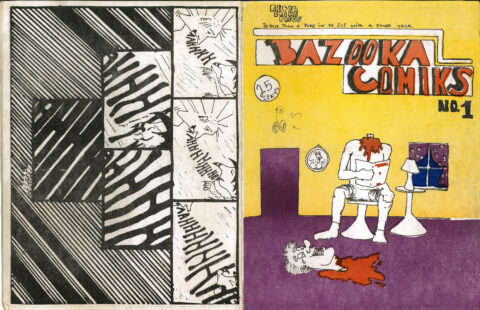
With all of this in mind, and taking into account my mission of presenting forgotten Canadian comics, this month I am excited to discuss a two-issue series from the late-1970s that has the look and feel of a late-underground but is probably along the lines of what Bud Plant once described to me as “crudzines.” The series, Bazooka Comiks, is of note because it was created by members of the fledgling Vancouver punk rock scene prior to the explosion of hardcore punk. As such, the two issues of Bazooka Comiks can be treated as a time capsule from the beginnings of the Vancouver punk scene; that is, if you can decipher the self-referential nature of the publications. Let’s get started.
The punk rock scene in Canada emerged in the late-1970s in response to the popularity of the genre in the United States and the UK. The two major Canadian scenes developed simultaneously in Toronto and Vancouver. Punk rock bands quickly proliferated across Canada and scenes popped up in other cities during the early-1980s.
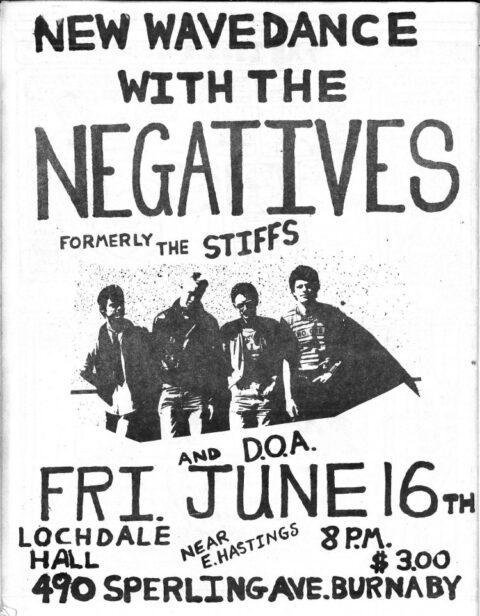
The very first punk rock show of note in Vancouver occurred at the Japanese Hall on July 30, 1977, and featured performances by the Furies and the all-girl group the Dishrags (whose members were in high school and travelled from Victoria to play the gig). The Furies quickly broke up and the Dishrags only played sporadically after this first concert. With this in mind, the early Vancouver scene was led by two bands who are still well-remembered by Canadian audiophiles today: D.O.A. and the Subhumans (not to be confused with the British band of the same name). In some ways, the Vancouver scene started with a band called The Skulls, whose members would eventually split off into D.O.A. and the Subhumans. Other members of the early Vancouver scene included bands such as Young Canadians, Modernettes, Pointed Sticks, the Stiffs, Rabid and the Braineaters (who I mentioned before in my overview of Lord Larry and in my discussion of collecting vinyl records and Silver Age Canadian comics). Of course, the Dayglo Abortions were making noise in Victoria around the same time.
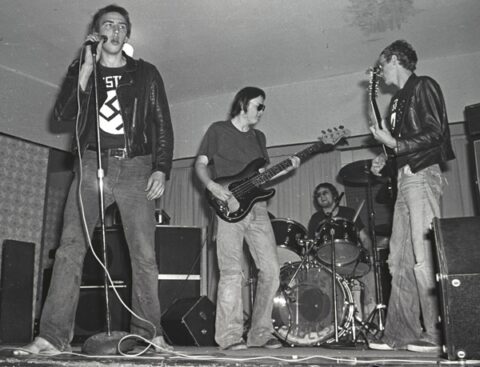
Of all of the bands from the original Vancouver punk rock scene, D.O.A. has arguably had the greatest impact on the history of Canadian punk music. They toured relentlessly across Canada and the USA cut several well-regarded albums and were the first Canadian band to refer to their sound as “hardcore” when they released their second album, Hardcore ’81, in 1981. D.O.A and the Subhumans influenced the sound of Canadian punk bands that started appearing in other cities across Canada in the early to mid-1980s, including Edmonton’s SNFU (who relocated to Vancouver), Toronto’s Bunchofuckingoofs, Montreal’s The Asexuals and Fredericton’s Neighbourhood Watch. For a detailed overview of the early Vancouver punk rock scene, I recommend checking out the Bloodied but Unbowed website that was created to promote the documentary of the same name.
In 1979, the Vancouver punk scene was still in its infancy. D.O.A. was starting to gain momentum, having put out a couple of 7” singles and embarking on its first North American tour. Nevertheless, the scene was quite tight-knit, with people playing in various bands together and everyone knowing everyone.
When Robin McConnell first posted about the first issue of Bazooka Comiks on his blog back in 2012, he had no way to understand the context of the comic. Fortunately, noted Vancouver punk rock photographer and historian Bev Davies reached out to him to fill in some of the gaps. Much of what I will present today stems from what Davies told McConnell, but I will flesh this out in more detail, while also filling in some additional blanks.
Bazooka Comiks was something of an organic extension of the Vancouver punk scene. The series was edited by D.O.A.’s original roadie, Bob Montgomery. Montgomery was one of three brothers who were recognizable faces in the scene: the others being drummers Charles (aka “Chuck Biscuits”) and Ken (“Dimwit”). Dimwit had been one of the original members of The Skulls and joined the Subhumans as their original drummer. Dimwit would play drums for Pointed Sticks and eventually D.O.A., as well as The Four Horsemen. He died in 1995 from a drug overdose.
Meanwhile, Chuck Biscuits was the original drummer for D.O.A. from 1978-1982. He would leave D.O.A. to briefly join Black Flagg in 1983 and then the Circle Jerks from 1983-84 before becoming a mainstay with Danzig from 1987-1994. In the late 1990s, he drummed with Social Distortion. In the process, he has become one of the best-known drummers in punk music.
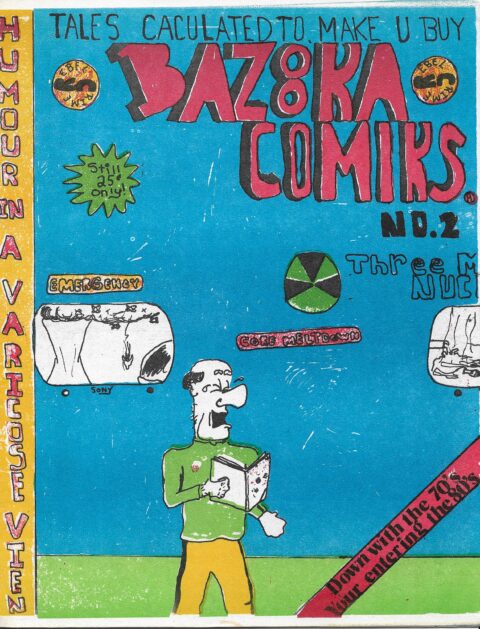
The two issues of the magazine-sized comic would not have come to fruition without the help of Dave Gregg. At the time, Gregg was the guitar player for the short-lived band Private School (which only released one 7” EP, “Lost in Action,” in 1979 before disbanding). Gregg worked at a print shop at the time and helped numerous Vancouver punk bands print gig posters. His access to printers enabled Bazooka Comiks to get published using the name “Rebel Crime Press” in its cheap, black and white copied form (with only the covers having colour). The first issue debuted sometime in 1979, while the second issue appeared in late-1979 or early-1980. By 1980, Gregg was the backup guitar player for D.O.A., appearing on the band’s first five albums. Dave Gregg died in 2014.
Both issues of Bazooka Comiks feature contributions from members of the Vancouver punk scene in the form of short strips. All of the strips are extremely amateurish, with Bob Montgomery adding quite a bit of filler to each issue. Unfortunately, Bob Montgomery was not much of an artist. Even so, there are several in-jokes and references to the punk scene found in each issue that are noteworthy (even if the artwork itself is not).
Perhaps the best artwork in the series is by a person using the pseudonym “Ray Gunn.” Davies explained to McConnell that Ray Gunn was a person who liked to draw dinosaurs, but does not elaborate or provide anything to help identify who this person is/was. Ray Gunn provides two stories in the first issue and returns for Bazooka Comiks # 2. One of the stories in issue # 1, called “K-Tels in Logo-a-Go-Go” directly references the fledgling Vancouver punk scene in several ways. First, the K-Tels was the original name of the band that would become the Young Canadians, which released two classic Eps in 1979 and 1980. The band was led by Art Bergmann who would become a key member of the Modernettes. The trio was rounded out by musicians Barry Taylor and Jim Bescott. Ray Gunn’s comic also references the short-lived post-punk/art-rock band UJ3RK5 that has gained notoriety among audiophiles in recent years.
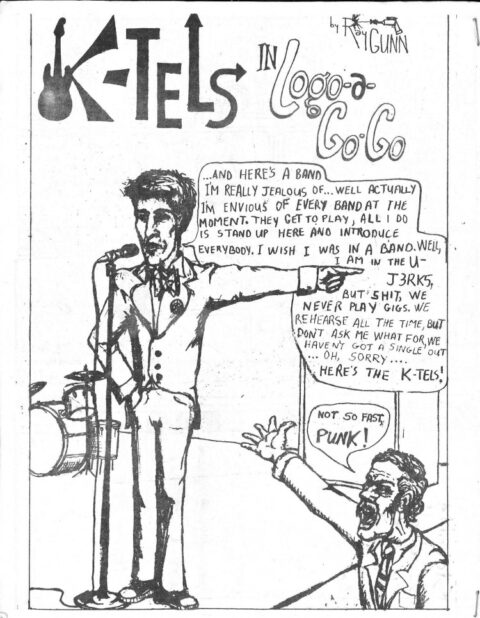
I have been unable to learn the identity of Ray Gunn and it is unclear if this person was performing with any of the upstart punk bands in Vancouver at the time. Today, a well-known male burlesque dancer based in Vancouver uses the stage name “Ray Gunn.” Collectors and researchers, please be advised that this is a completely different person.
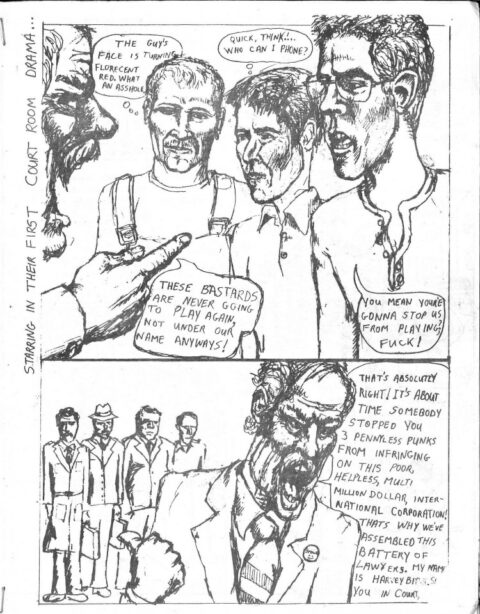
Bazooka Comiks # 1 also features are strip called “Rebel War” by Jon Doe. A second edition of the strip appears in Bazooka Comiks # 2. Jon Doe was the pseudonym of Jon Williams who played guitar for Rabid and the Scramblers. Rabid only played a handful of shows, but featured performances from Dimwit, Chuck Biscuits, future D.O.A. member, Simon Wilde, and former members of the Stiffs, Sid Sick and Zippy Pinhead. Original Stiffs members Mike Normal and Gerry Useless (aka Gerry Hannah) would later form the Subhumans with Dimwit and “Wimpy” (aka Brian Roy Goble).
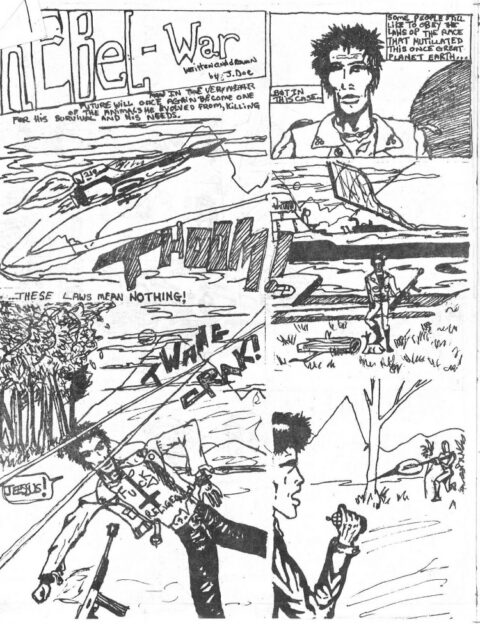
One of the things that Bev Davies did not mention to Robin McConnell is the significance of Zippy Pinhead. Underground comix enthusiasts will recognize the name Zippy the Pinhead as the title character from Bill Griffith’s comic strip Zippy. However, Zippy Pinhead was also the nickname of one of the best-known punks in the Vancouver scene (taking the name from Griffith’s character).
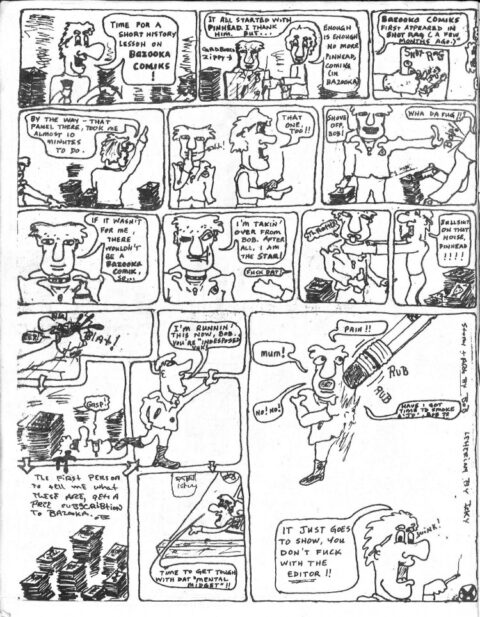
Zippy Pinhead’s real name was Bill Chobatar and he was born in Alberta. His father was in the RCMP and was posted to Port Moody, BC when he was in high school. He met the Montgomery brothers when they were in high school and quickly met the punks from Burnaby (Wimpy, Gerry Useless and Sid Sick). Zippy Pinhead would become a mainstay of the Vancouver punk scene for decades to come, despite never achieving the fame or success of his friends who would form D.O.A. and the Subhumans. Although Zippy Pinhead did not contribute to either issue of Bazooka Comiks, he appears as a recurring character in both issues of the series in strips by Bob Montgomery. Chobatar died from a heart attack in 2019.
The first issue of Bazooka Comiks also features a short comic by Bob and Dimwit about their dilapidated dwelling on Gore Street called “Tales from the Squat.” An early D.O.A. and the Stiffs gig poster is also reprinted towards to end of the comics.
In the credits section, a comic that does not appear in the issue is credited to Chuck Biscuits and Mike Normal called “Twelve Easy Steps to Becoming a Punk Guitarist.” My best guess is that they never actually drew the comic, but that the credits were already written and could not be changed when the comic went to print. There are a couple of other people mentioned in the credits with pseudonyms such as “Icky McNickel” and another one that I cannot make out that I have been unable to learn anything about. The back cover, however, was drawn by female punk photographer Cram, who left the scene in 1984, but would resurface briefly in 2017 with another female punker named “V” with the podcast “Punk Off,” which lasted for twenty-five episodes. Cram would also contribute to Bazooka Comiks # 2.
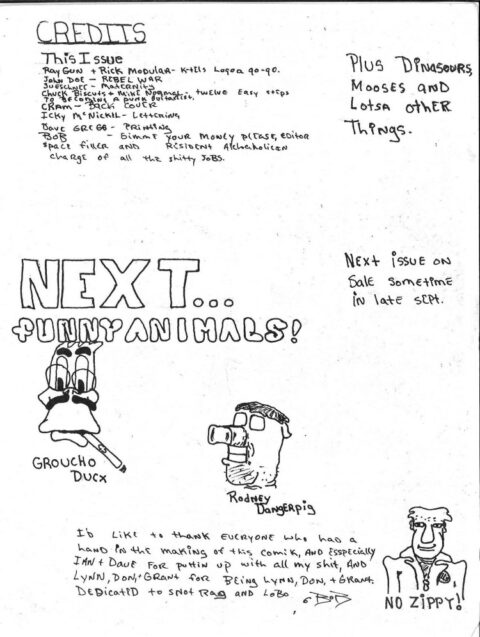
The acknowledgements at the back of Bazooka Comiks # 1 are also revealing. Bob Montgomery thanks Ian and Dave, as well as Lynn, Don and Grant, while dedicating the comic to Snot Rag and Lobo. Presumably “Dave” is Dave Gregg, while it is unclear to me who Ian and Don were/are. Interestingly, Lynn is actually Lynn McDonagh, who is another well-known female photographer who worked with the seminal fanzine Snot Rag. Her brother, Grant McDonagh, is also thanked here. Grant would go on to open Zulu Records in 1981, which was both a storefront and record label. The shop still exists today and is widely regarded as one of the most famous independent record stores in Canada.
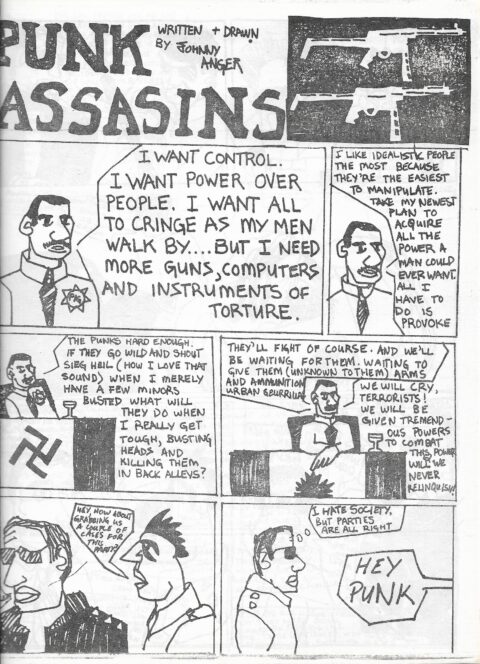
It is unclear when exactly Bazooka Comiks # 2 was released, though my best guess is either late-1979 or early-1980. The second issue of the series picks up from where the first left off, with Bob Montgomery’s crude artwork working as filler around the more advanced comics drawn by Ray Gunn, Jon Doe and Cram (who contributes a proper strip this time around). Dimwit also contributes a crude three-panel strip at the end of the issue.
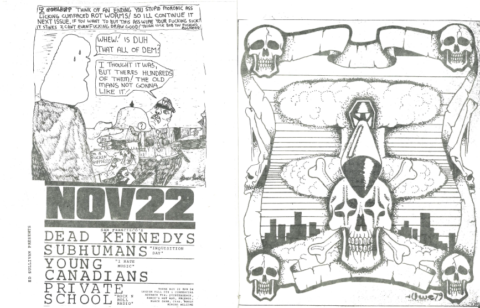
Otherwise, Bazooka Comiks # 2 is made up of content from newcomers, most of whom I have not been able to identify, including Paul Hennig, Chris James, Johnny Anger, Keif and Uwe. It is unclear who these individuals are, but it is almost certain that they were part of the scene as musicians, fans, or both. That said, a major figure from the scene contributes a crude three-and-a-half-page comic to the issue called “Smilin at the Buddha.” The creator of the strip, Simon Snotface, has continued to be a fixture of the Vancouver punk scene. Originally opened in 1953, the Smilin’ Buddha was one of the main venues in the city for punk rockers from the late-1970s until its closure in 1993. The venue made a comeback after its first closure but ceased being a performing venue in 2019 after a pedestrian was severely injured in an accident involving a tour van for the American punk band Off with Their Heads.
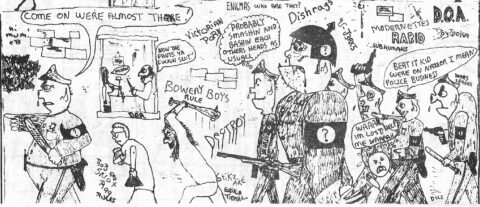
Apparently, Bob Montgomery planned to continue Bazooka Comiks. Unfortunately, a third issue was never published. By 1980, D.O.A. and the Subhumans (and the Vancouver punk scene in general) had taken off. The most successful bands toured relentlessly and I suspect that the series was put on the back burner and was never picked up again.
Both issues of Bazooka Comiks are incredibly rare today. It is unclear how many copies of each issue were published, but I cannot imagine more than a couple hundred each. I was fortunate to be able to obtain copies of both issues due to the sleuthing of Dan Bryantowich, who had some contacts in the Vancouver punk rock scene when we first started researching the Canadian Silver Age five years ago. Dan was able to pick up copies for me and himself about four years ago and I have not seen specimens come to market since.
Dan’s sleuthing did uncover a third publication that may be of interest to D.O.A. fans (and punk rock enthusiasts in general), but which is not a comic book. Sometime after Dave Gregg joined D.O.A. permanently, Richmond cartoonist Ken Forster designed a “D.O.A. and Friends” colouring book, which was sold at Zulu records. From what we understand, only 100 copies were printed. We have never seen one come up for sale, but Dan was able to find an image of the cover and a news article about the colouring book after quite a bit of effort.
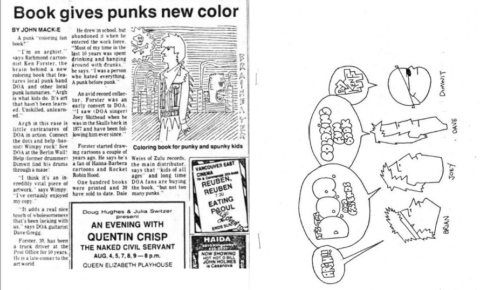
Given that these comics were self-referential, DIY creations of young punk rockers who were part of a scene that had yet to take off, these were never intended to be collectible. The fact that the Vancouver punk rock scene would propel numerous figures to the status of punk rock legends in the years that followed suggests that these two comic books (and the colouring book) should be quite desirable in today’s collector’s market. These are perfect crossover collectibles for punk rock enthusiasts, comic collectors and people interested in Canadian pop culture in general. Unfortunately, until specimens come to market, the jury will be out in terms of potential value. Until then, I will be happily listing to some of these bands’ albums and EPs on my turntable.

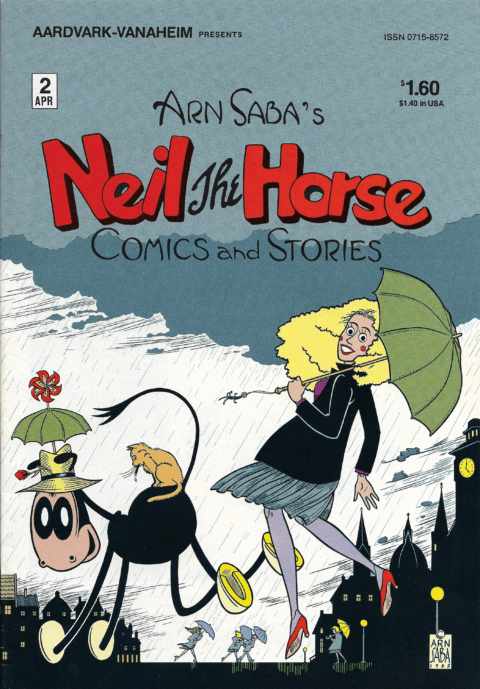
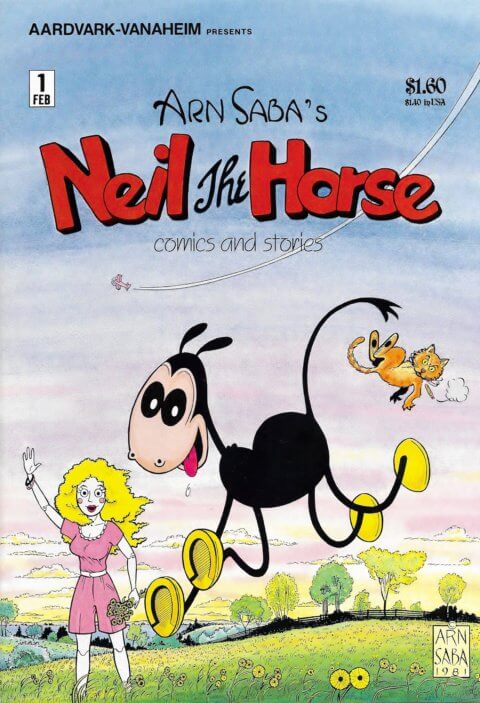
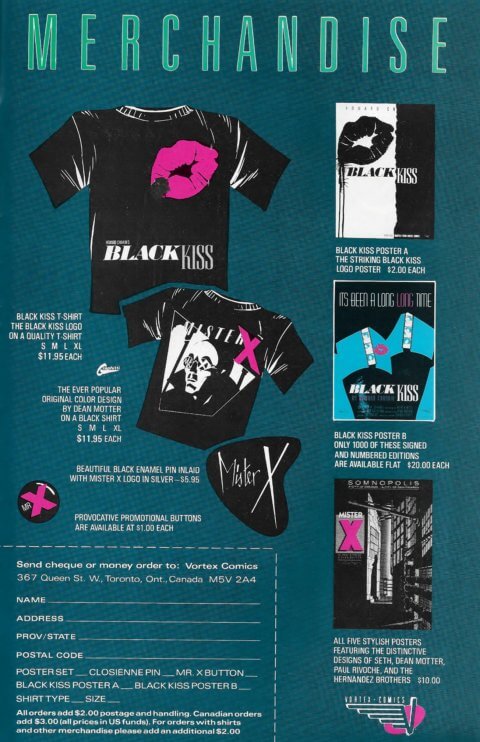
Nice work, as always!
–Rick
Thanks, Rick. Much appreciated!
Great stuff, brian. More of us need to turn up the surface soil of these eight decades of Canadian comics and bring attention to things that have been lost or forgotten and the people behind them.
Thanks for this brian! I have always thought of the punk zines of the late 70s and early 80s as the precursors to the comics zine explosion of the 80s. This is an interesting crossover of the two and therefore definitely worth pursuing.
cheers, mel
Thanks, Ivan, and agreed. If my column leads to increased interest in these overlooked and forgotten comics then I have accomplished one of my main goals. I am sure that you feel the same way about your own research and writing.
Hi mel. I think that there is a great amount of overlap between the proliferation of non-comic zines and mini comics during the late-1970s and early-1980s. The most obvious explanation is that photocopiers enabled creators to produce their zines and comics much easier (and cheaper) than ever before. By the mid-1980s, this technology was readily available, but before then there was definitely a transitional period from underground comix to alternative minis. The fact that the issues of Bazooka Comiks are magazine size is part of this transition. I think if this series was released five years later it probably would have as mini comics.
Hey brian, I don’t know your email, so I thought I would post here. There is a comic on ebay Canadian comics listing with a $1.50 bid that looks like it would be interesting to you called Canadian Worker Comics.
Thanks, Klaus. We have been tracking the Canadian Worker Comics that recently came to market and will be keeping a close eye on it. Easiest way to contact me is through Facebook @EastCoastToysandGames
My old Wang 286 (sorry Spider) can’t do Facebook.
My knowledge of punk rock just went up 1000%. Interesting all the co-mingling of bands and people….glad to see most of the players survived the wild times.
Since you brought up Geoge Metzger, I have to do a shoutout. George lived in San Jose, where I also hailed from back then, in the 1960s, very close to San Jose State. He turned us teen Marvel and DC fans onto to Japanese/manga, which back then you could only find in the “Chinatown” section of San Jose and of course only in Japanese. That was the same “chinatown” I’d ride my bike to find firecrackers for July 4th.
George was into all the great comic artists (makes me think of Al Williamson and Roy Krenkel, who were also very deep into vintage comics artists and book and magazine illustratgors, even as they became pros.. George bought ECs from our first store(s), just a few blocks from where he lived. Our one story is of him buying an EC from us for a couple dollars and folding it in half and putting it in his back pocket, somewhere between 1968 and 1970. Condition was not an issue with George, there’s a purist fan for you.
His work for the 60s fanzines Graphic Story World and Star Studded Comics was outstanding, some of the finest “fan” artist work of the sixties. First Richard Kyle and then Fantagraphics collected some of this work into book collections. George also ran his serial sci-fi strip, I think it was Beyond Time and Again, in the local “hippie” newspaper, The San Jose Redeye. One day I was downtown with some buddies and a guy came down the street with a shopping cart filled with Redeye issues. We asked what was the deal, and he said he’d been told to dump them however he could, and was looking for a big trash can or dumpster. I loaded them into my buddie’s car and for the next few years offered them in my catalogs and ads, due entirely to George’s work there.
George’s underground comics, Truckin’ and Moonddog, were published by The Print Mint, who published Zap Comix. I just found he’s got a Wikipedia entry and I had forgotten he also contributed to Gothic Blimp Works, the UG newspaper/comic hybrid that also had Wrightson and other young comics pros in it.
George moved up to my present area near Grass Valley, before he went off to Seattle, and toyed with a Sufi group here and did a comic or two about Sufi stuff, that I think were too strange for even me to handle. I lost touch with him after the Seattle move, but I think he had a vintage clothing shop there. And I see he worked in their animation industry. Check out his Wiki page. Really nice guy, glad to see he’s still around.
I wish I could remember if I saw a copy of Bazoooka. Another comic to look for in my magazine boxes, since I saved sample copies of things that I didn’t to choose to handle back then. Brian, I still owe you some old catalogs, I’ll try again to put a package together for you. Early 1980s was it?